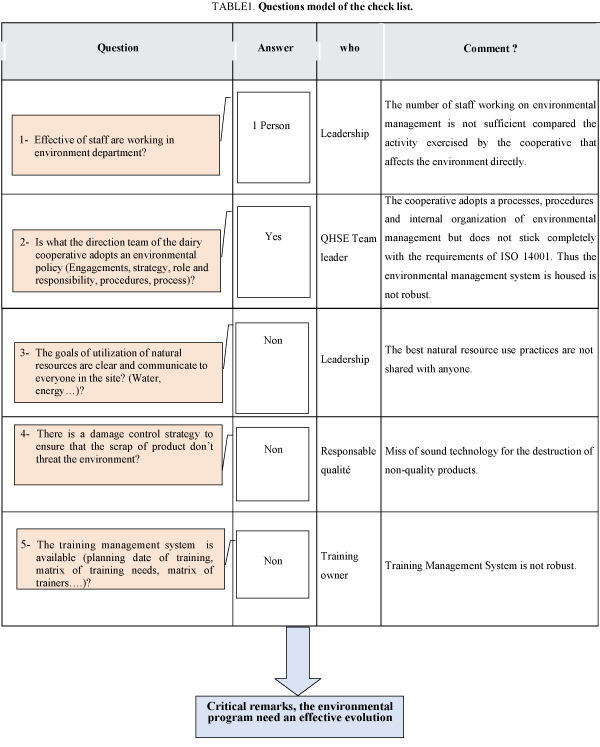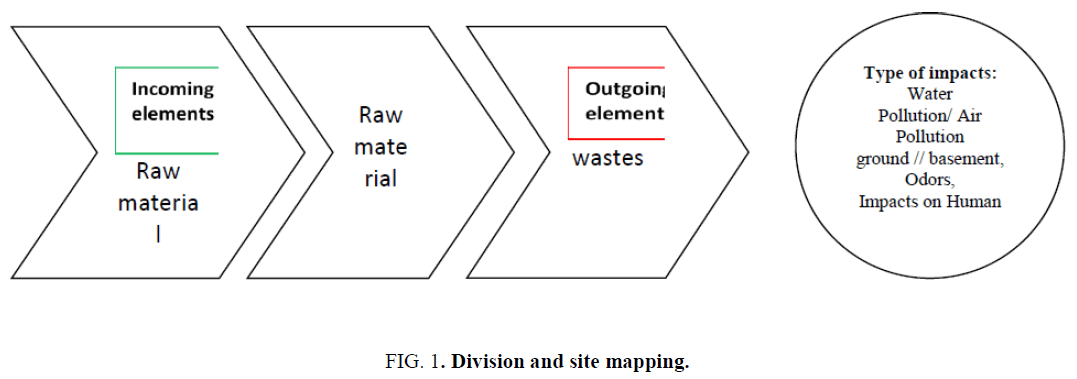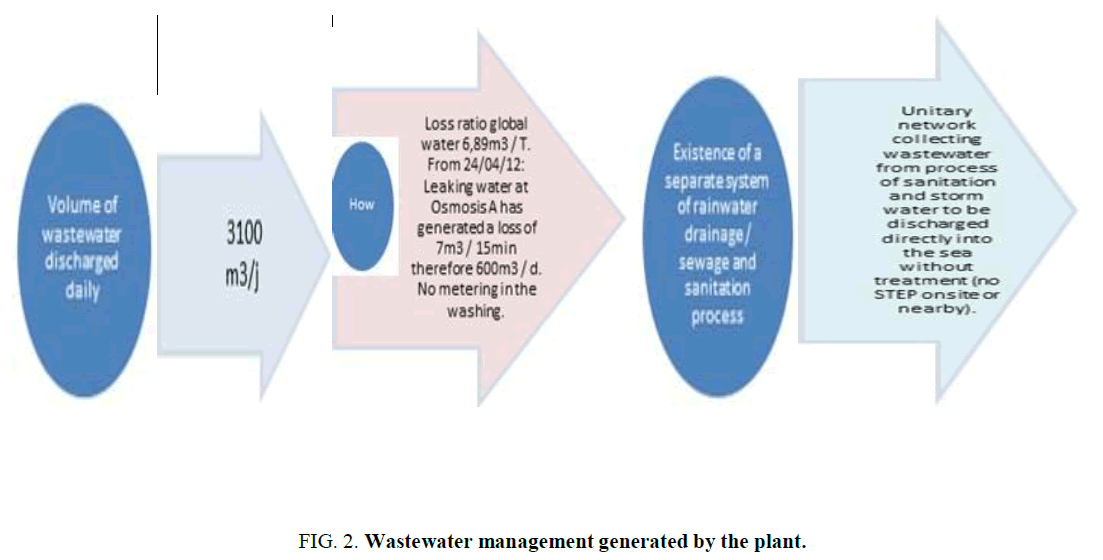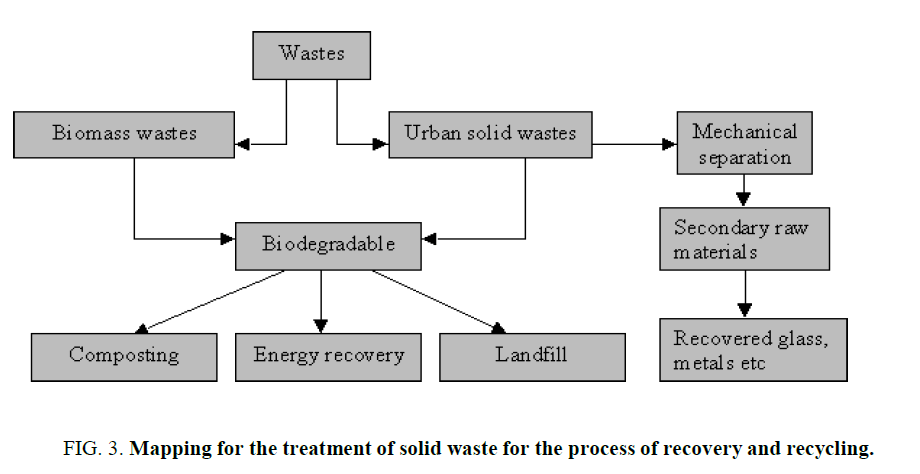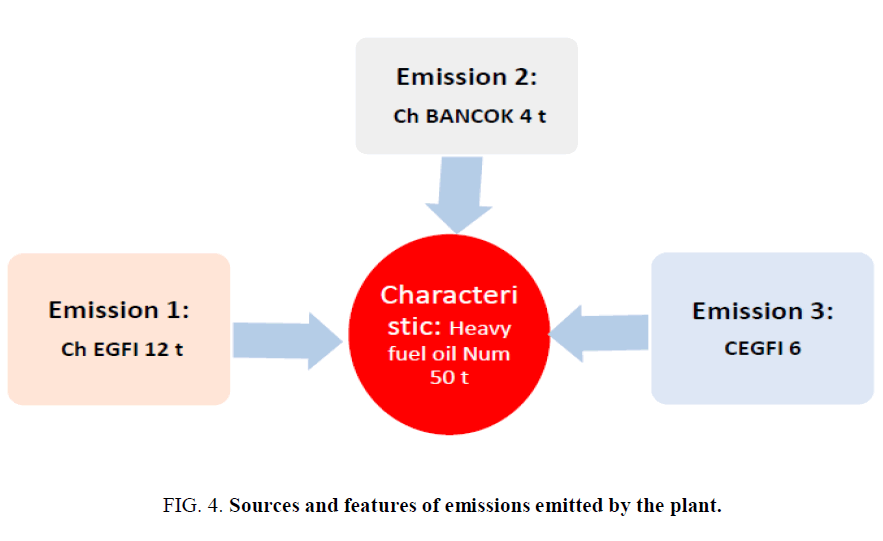Original Article
, Volume: 12( 11)Control of the Environmental Management System Performance According to ISO 14001 Standard Version 2004 of the Agriculture Dairy Cooperative in Kenitra City ë EXTRA LAIT û - Morocco
- *Correspondence:
- El Hour S , Laboratory of Biotechnology, Environment and Quality, Faculty of Science, Ibntofail University, PO Box 133, 14000, Kenitra, Morocco, Tel: 212-537374052; E-mail: s.elhour@gmail.com
Received: October 14, 2016; Accepted: November 06, 2016; Published: November 16, 2016
Citation: El Hour S, Aouane M, Chaouch A. Control of the Environmental Management System Performance According to ISO 14001 Standard Version 2004 of the Agriculture Dairy Cooperative in Kenitra City « EXTRA LAIT » - Morocco. Environ Sci Ind J. 2016;12(11):125.
Abstract
Aim: The target of this scientific study involves implanting practical component and steps to setting up of an environmental program and provides a performance control of environmental system. Method: Among the most important Agriculture Dairy Cooperative in Morocco, “Extra lait” is leader in dairy products in Morocco; it has experienced significant development in terms of improved environmental performance. The Agriculture Cooperative seeks to demonstrate its commitment to improving its environmental performance level; it has developed a project to implement an environmental management system. Results: In general, after the check of the result, the major remarks that the process of a dairy industry of this agriculture cooperative generate an important element of environmental pollution (dairy processing waste, pollutants from livestock operations, volatile organic compounds (VOCs), heavy metals, chemical waste, and others) with high organic load (3100 m3/J).
Keywords
Agriculture dairy cooperative “Extra lait”; ISO 14001; Performance control; Environmental system
Introduction
ities of enterprises becomes a critical concern and a major obligation is made by thinking on the reduction of critical environmental impacts at the production site by adopting the EMS aimed at continuous improvement of its environmental performance by integrating environmental concerns different business activities of the company.
Method Adopt
Situational Analysis
Many dairy cooperatives have found a tool and a technical for the setup of the Environmental System in order to ensure a good management of their environment site and to obtain the certificate ISO 14001 version 2004, because, the official recognition of the EMS company through its certification its certification [8].
This section allows studying the internal evaluation of the environmental program degree within the dairy cooperative. The internal evaluation is derived around 11 topics, for which it is appropriate to answer some questions. It is important in a first step clarify that the site direction team is actively involved in the environment management system.
Leadership demonstrates a commitment to the establishment and maintenance of an environment system within each site and the organization as a whole. They set clear operating standards for site activities and ensure that these standards of environment program are communicated to individuals and reinforced through personal example, defined responsibility and clear accountability. Leadership ensures that the organization is designed and developed a strong environment program.
The company's reviews and meetings should know the requirements of the ISO 14001 standard and define their conformity percentage. A Check List presents a model for analyzing the anomalies and failures within the company according to the requirements of ISO1400 Standard. In below Table 1 an example of the environmental strategy.
Table 1: Questions model of the check list.
The Environmental Assessment
The environmental treatment and analysis is realized in three different tread which are the subject of a participatory approach at all degrees of the organization to involve staff in the analysis, so the targets are identified and determinate, the diffe rent steps of Environmental analysis are:
Process of the dairy cooperative “Extra lait” Area.
During the time of the completion of our study, we have divided and distributed all the activities of the dairy cooperative i n the form of activities and sub processes to properly treat and analyze the environmental aspects and impacts. (Storage and logistic area, housekeeping area, infrastructure, production Figure. 1.
Define the Environmental Aspects and Impacts
The EMS is a system and database which integrates procedures and processes for training of personnel, monitoring, summarizing, and reporting of specialized environmental performance information to internal and external stakeholders of a firm [9]. In the same context the aim of the environmental analysis is to implement and to define and prioritize the negative environmental impacts "significant" and "manageable". In view of these considerations, it is indeed very important to conduct a comprehensive identification of aspects related to the activities and products of each area in normal operation / accidental. After analysis of the different components of the production process (dusting, boiler, pasteurization ...), cleaning operations of, a cooperative internally and externally, we notice that the water is consumed from an interestingly and a huge amount whatever the waters distributed by the national office of water or well water treated.
Many industries use large volumes of water in their manufacturing operations. Because some of this water becomes contaminated, it requires treatment before discharge gives the facts concerning the drinking water at the site level.
Improvements in determining the effects of industrial waste discharges have led to the adoption of stringent environmental laws, which define the degree of treatment necessary to protect water quality. Discharge permits, issued under the National Pollutant Discharge Elimination System.
Regulate the amount of pollutants that an industry can return to the water source. The permitted quantities are designed to ensure that other users of the water will have a source that meets their needs, whether these needs are for municipal water supply, industrial or agricultural uses, or fishing and recreation. Consideration is given to the feasibility of removing a pollutant, as well as the natural assimilative capacity of the receiving stream. This assimilative capacity varies with the type and amount of pollutant.
Wastewater treatment plants are designed to convert liquid wastes into an acceptable final effluent and to dispose of solids removed or generated during the process. In most cases, treatment is required for both suspended and dissolved contaminants. Special processes are required for the removal of certain pollutants, such as phosphorus or heavy metals.
Wastewater can be recycled for reuse in plant processes to reduce disposal requirements. This practice also reduces water consumption.And finally, to validate this step, the cooperative leadership must to develop an assessment of the competence of personnel on the basis of predetermined skills matrix system defines the standard by which the company must comply [10] Figure. 2.
Figure 2: Wastewater management generated by the plant.
Treatment of solid waste
In an industrial facility, solid waste is generated in a number of ways. For example, if a manufacturing process generates “scrap” that cannot be reused, it may be treated as a solid waste. Think of a shoemaking facility, it is eas y to imagine scraps of leather, rejected from the cutting equipment that cannot be reused Figure. 3 [11].
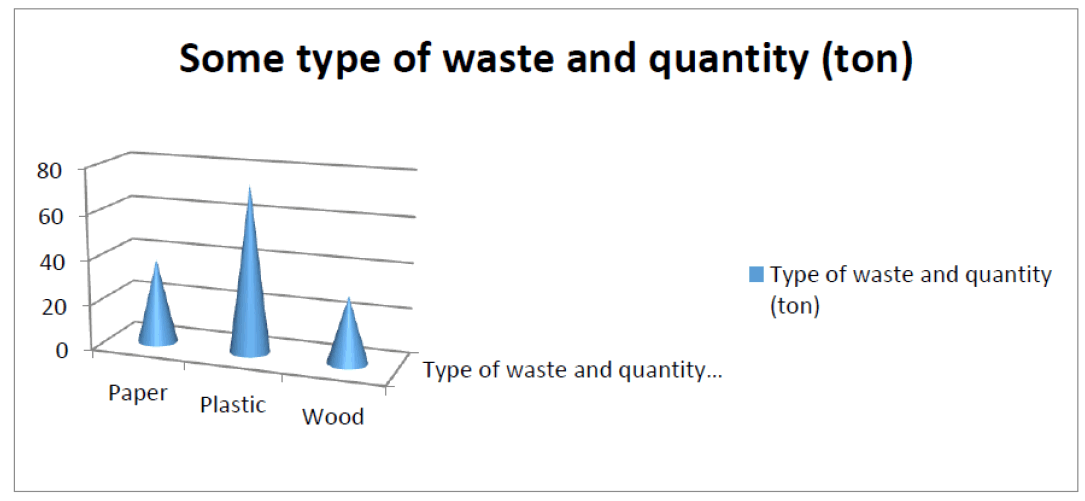
Atmospheric Emissions
An atmospheric emission is much more advanced and accurate than the assessment of Hg releases to the two other compartments of the environment. Atmospheric emissions are also responsible for the global distribution of Hg via air transport and are thus relevant for a global assessment [12].
Air emissions are captured, the need clean, conducted at the discharge point and evacuated ensuring satisfactory dispersion in the atmosphere Figure. 4
Result of Control of the Principal Elements Environmental Management Program Performance According to ISO 14001 Standard Version 2004
To give an overview of the control the environmental management program performance according to ISO 14001 standard version 2004 of the Agriculture Dairy Cooperative in KENITRA city « EXTRA LAIT » subject of our investigation, we propose to introduce a whole criteria for determining the EMS and the main axes improvement over the weak points detected at each element different requirements of ISO 14001.
Thus, every business needs to know the requirements of the regulations, industry codes, standards and permits that must be respected. Organizational systems are needed to ensure compliance and appropriate monitoring and possibly prepare reports [13].
The control of the Environmental Policy
The control evaluation of environmental policy rate is 53.14%, which is an average result, the criteria for assessing the environmental policies Agriculture Dairy Cooperative in KENITRA city « EXTRA LAIT » studied are:
An environmental policy covered by the Branch, shows the commitment to the environment. Commitment is primarily focused on continuous improvement in the field of environmental protection. Environmental policy exists but is not well updated and it is not very well communicated.
The control of the planning
The results of the evaluation of the Planning show that the best performance lies in the objectives, targets and environmenta l programs, an average performance Level of legal and other requirements and environmental aspects.
Environmental planning must begin with the identification of significant environmental aspects of each company according to its nature of business and its location.
It is imperative that each companies compliance with legal requirements and other requirements to establish its environmental objectives and targets to develop its programs [14].
Resources, Roles and Responsibilities
According to the responses of our interview the Agriculture Dairy Cooperative in KENITRA city « EXTRA LAIT », we have remarked:
In environmental matters, responsibilities are known but not formalized.
During our various interviews with leadership and the pilot of environmental and quality process, we have seen a pretty good awareness regarding environment, but its implementation remains somewhat limited. In general, a lack of resources for the implementation and improvement of the EMS.
Training Key Element
There is a training plan for each employee, linking required skills to roles. A training matrix is used to track training sta tus. Qualification of training is conducted by written test and for loaders/un-loaders there is an additional on the job training. There is a 100% success criteria for all qualifications. An onboarding programme is in place for new employees. Re- qualification of employees is performed annually.
The major remark is that written qualifications are not being assessed properly. There were several errors and anomalies on the test papers which indicated they were being done purely to meet the targets versus actually confirming if operators properly understood the training being given. Some examples are shown below:
The qualifications for Basic QA for both Hassam Guazir and Youssef Alfatihi who both do exactly the same role as “Prepareteurs” were different, for example Q11 was answered as “Non” by one person and “Oui” by the other and both were marked as correct. Q12 was answered as “Vrai” by one person and “Faux” by the other, and again both marked as being correct. Q16 nothing answered by Youssef Alfatihi but marked as correct.
Qualifications for Amam Abdelah did not answer specific questions: e.g. for “Environment” - Q2, Q4, Q6 and Q8; for “Pest Control” - Q4 and Q6; for “Rewards & Recognition” - Q10. Again these were all marked as being correct and some not marked at all.
Qualifications for Jamal Fadani did not answer specific questions: e.g. for “Environment” – Q2, Q4, Q5, Q6, Q7, and for
“Basic QA” – Q6 and Q8. Marked as correct and some not marked at all.
Open questions were being used on several qualifications but they all differed in context and the number of answers given. The same questions had 1/2 answers and sometimes 4/5 answers given by the trainees. However every answer was marked as correct. There is no standard format defined by the site so the answers are subjective.
And there is no record to show that temporary workers have been given any sort of Environmental training. It is expected that all workers receive some level of Environmental training. Everyone working in the site can contribute to the Environmental program and should therefore be trained at least in basic Environmental expectations. Documents should be available to confirm this has been done.
Results
The results of diagnostic of the "check list"
Percentage
Compliance: According Check List we have 58 requirements according to ISO 14001:
40 Non-Conforming, issues, anomalies, non conformity. (deviations)
18 Compliant.
We have found the following compliance percentage:
40/58 * 100 = 68.96 % (NC) Not compliant,
18/58 * 100 = 31.03% (C) Complies
Therefore the company meets 31.03% with the requirements of ISO 14001, the results show that there are deviations, to be
100% compliant with the requirements, the LC must implement compensatory measures to minimize the differences.
Results of Environmental Analysis
Written procedures
An uncontrolled copy of a procedures was found in the shipping operation concerning the “Housekeeping and cleaning” of vehicle doors after loading. This has been created by the supplier team, but there is no visual reference to the local site procedures and it is not included in the master file of site procedures.
And the single set of procedures available within the operation is not well controlled. The documents are not maintained in a folder/file and are simply kept as a pile of loose leaf papers in a wooden filing “box” in an office area. If the site really intends for people to use the procedures, then the method of filing and location of the procedures must be improved. The current system risks documents being lost and not used.
Analyze results of the environmental aspects and impacts
Aspect: The physical happening of the activity. Every activity can give more than one impact.
Impact: The effect on environment due to the aspect generated when any activity takes place.
In generally, the environmental aspects are further sub-divided into three groups: Normal operation, abnormal operation and emergency operation.
The main impacts on the environment are: air pollution, water pollution, noise pollution ….
Listing (Evaluation scale)
The calculation of the global rating appearance is achieved by multiplying the scores for each criterion.When listing the environmental aspect is greater than the significance level, the appearance is said to be significant. If fo r one aspect, the site is not in compliance and some of its rating; it will be declared significant for the envir onment. To assess this, we applied the scoring table.
Water pollution
Water pollution can be defined in many ways. Usually, it means one or more substances have built up in water to such an extent that they cause problems for animals or people. Oceans, lakes, rivers, and other inland waters can naturally clean up a certain amount of pollution by dispersing it harmlessly; the phenomenon of water pollution has been referred to in many texts-legal writing and rules not excluded- without an attempt being made to properly define the phenomenon [10].
The causes of water pollution
Sewage
Nutrients
Waste water
Chemical waste
Radioactive waste
Oil pollution
Plastics
Alien species
The different way to stop water pollution
Education
Laws
Economics
Distribution of Significant Environmental Impacts (Aes)
According the results that we have obtain, we found 69 environmental aspects identified in the site, the significant environmental impacts represents 25%; it corresponds to the first generation of waste, followed by water pollution, and air pollution, resource consumption and finally the noise emissions. This prioritization of significant environmental impacts resulted largely to define action plans. In general, the process of a dairy industry involves water consumption and significa nt energy and large volumes of waste water with high organic load. For this reason, we have proposed a variety of Clean Production Opportunities in order to reduce consumption and final discharge without production is so far affected.
Analyze and Discussion
This paper discusses the elements of environmental management systems, the relationship to the ISO 14001 standard, and the importance for Agriculture Dairy Cooperative to implement an EMS.
In our study on EMSs Agriculture Dairy Cooperative in KENITRA city « EXTRA LAIT » found that the major obstacles for implementing ISO 14001 standards were: Effectiveness needs to be proven about the training program, Actions plan follow - up needs improvement for tracking of environmental actions, the standards operating procedures is not ef fectiveness.
The Clean Production Opportunities were classified according to the following points:
Update environmental policy and date update on environmental policy statement of the Agriculture Dairy Cooperative in KENITRA city « EXTRA LAIT ».
1. Develop a communication plan effective environmental policy.
2. Identify permanently the environmental aspects of their activities, products and services within the area defined for the Environmental Management System,
3. Identify areas that have significant impacts on the environment (Significant Environmental Aspects).
4. Determine how these requirements apply to its environmental aspects.
5. Establish an evaluation of the effectiveness of the training system. (Evaluation of the trainer, training and trained).
6. They must measure the effectiveness of communication about the EMS.
7. Reviewing the effectiveness of corrective actions and preventive actions implemented [15].
8. Leadership ensures that the site is designed, staffed and capable of delivering intended quality products with a respect of environmental aspects, so the EMS must be sponsored by leadership.
There is a system capable of demonstrating the current level of training and qualification about the EMS in the organization.
Conclusion
It is therefore essential to take action to remove even reduce the negative effects to do this, there are a number of environmental assessment tools among them, The Life Cycle Analysis (LCA) Analysis of the effects of their failure modes and their criticality on Environmental (FMEA-E) the Environmental Impact Assessment Study (EIA), environmental audits etc.\
An EMS refers to structures, practices and control that an organization uses to manage its environmental aspects and impacts and to achieve its performance objectives1. An effective EMS requires that the organization:
1. Establishes and communicate its environmental commitment and goals through its environment policy.
2. Plans programs for controlling the environmental aspect and impact of its products, process and activities.
3. Implements programs and control operations to achieve these goals.
4. Checks results and corrects problems
5. Reviews and improves the performance of the system
In the same context, the setting up of a management program according to ISO 14001 standards proof a success story, it can provide an effective framework for developing environmentally benign processes and products, improving environmental performance and ultimately reducing the costs of complying with its environmental responsibilities.
Finally, by integrating economic development with environmental protection and social progress. Factor economic development as COP Paris 21 insisted.
References
- Boubaker L (2012) Contribution à l?intégration d?une politique environnementale dans les activités des entreprises algériennes en vue d?une amélioration de leurs performances environnementale.
- Président KZ (2002) de Sustainable Business Associates Guide d?auto diagnostic environnemental Outil degestion pour les entreprises.
- MZOUGHI N (2006) Analyze economic des approaches voluntaries de regulation de l?environnement Economies and nances. Universities de Bourgogne.
- Hervieu D, napias G, Tanguy M (1998) Le management environnemental, Dossiers d?experts, éditions de la lettre du cadre territorial.
- André S (2006) Evaluation synthesis ex post environmental performance of industrial sites, Sites where the entity refining company Total. Workbook Lamsade 241.
- Christopher Sheldon, Mark Yoxon (2006) Environmental Management Systems: A Step-by-Step Guide to Implementation and Maintenance. Routledge 3 edition 296.
- Prats A (2008) Establishment of an environmental management system. Edition:Technical Engineer 000v2 G 5.
- Sroufe, Robert (2003) Effects of Environmental Management Systems on Environmental Management Practices and Operations. Production and Operations Management 12: 416-443.
- Boiral O (2009) The environmental management system as ameans of controlling the variation and the emergence of environmental strategies. University of Poitiers, PhD in Management Sciences.
- Woodard & Curran (2006) Inc : Industrial Waste Treatment Handbook, Butterworth-Heinemann; 2 edition, 532.
- Jozef Pacyna M, Kyrre Sundseth, Elisabeth Pacyna G (2008) livre Socio-economic Costs of Continuing the Status-quo of Mercury Pollution. Nordic Council of Ministers Copenhagen 360.
- Audiffren T, Guarnieri F, Rallo JM, Lagarde D (2012) Compliance and Certification Survey Mines - ParisTech quantitative. Afnor Preventeo 54
